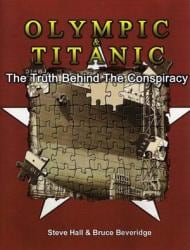 OLYMPIC & TITANIC - The Truth Behind The Conspiracy
OLYMPIC & TITANIC - The Truth Behind The Conspiracy
by Steve Hall and Bruce Beveridge
The Olympic–Titanic Switch Theory, for the uninitiated, rests on a proposal by Robin Gardiner that the damage inflicted on the Olympic in 1911 after a collision with the elderly warship Hawke, armed with a quaint but effective underwater ram, prompted the WSL to attempt an insurance scam. The crocked-up Olympic would be disguised as her almost identical sister, the new Titanic, then sailed out into deep waters, safely abandoned on a pretext, and allowed to quietly sink. The real Titanic would become the Olympic, sail on happily ever after, and the WSL would claim on Titanic’s insurance. Thus Gardiner’s thesis is that the ship two and a half miles down in the Atlantic is not the newer Titanic, but actually the older and terminally un-seaworthy Olympic. This proposition might make even the most factually-challenged of Titanic enthusiasts frown and say “But…..”, and it would be a brave person, on Encyclopedia Titanica, who publicly defended Gardiner’s conspiracy theory.
Luckily, however, for all those interested in fairness, two men have decided to put it to the ultimate test. And a rigorous test it is. The detailing of all the differences between the two ships, in order to lay to rest the theory that such a switch took place in the populous Harland and Wolff shipyard, in1912.
The great thing about conspiracy theories is, of course, that they are such fun. One must suddenly feel so much more interesting, for example, as a self-proclaimed alien abductee. Anyone writing cold, dismal facts disproving these entertaining wish-fulfilments runs the risk of being cold-shouldered as a killjoy. This is something the authors are aware of, but on this forum at any rate, if not among general Amazon customers, that risk is minimal.
So how good is Hall & Beveridge’s evidence refuting the conspiracy theory? Well, although only running to 200 odd pages plus some very large appendices, it is certainly impressive in terms of the bulk and diligence of research. Only consummate techies could have devoted themselves to the task of documenting the minute details of the differences between the two ships. The first part of the book is a ‘teaser’, which details the more puzzling and ‘believable’ aspects of the conspiracy theory, thus leading the reader to think there might be something to it. The latter part of the book attempts to refute this. Given the authors’ remit – to lay the conspiracy theory finally to rest – the obvious question is, “Do they succeed?” Oddly enough, the answer is that in one sense, actually, they do not quite. They ask some questions in the first part of the book which they do not actually answer in the second. Most of them, it must be said, are unanswerable, and the authors were not the ones to pose those questions in the first place – Gardiner was. However, it does leave a very tiny chink of light to illuminate the hopes of conspiracy theorists, which actually may be no bad thing if one is hoping to sell the book to the general public as well as to rivet counters.
They certainly succeed, however, in proving that the possibility of a substitution is so vanishingly small that it can safely be totally ignored.
What can be asserted, without fear of contradiction, is that the technical detail of the Olympic-class ships in this book will delight all whose primary interest is construction and operations. I am not qualified to verify the accuracy of the detail, but I have no reason to doubt it, and would be very surprised if there were any real errors, especially when one considers the sources and contributors referenced at the end.
The book is stuffed with photographs and diagrams contrasting the two ships, which of course provides the really compelling evidence, and the appendices include a concise history of both the Olympic and Britannic.
One does have to ask whether the book was worth the obviously considerable effort, and whom they hoped to convince. The informed audience for such a book, however, is quite small and easily targeted through the Titanic world. I know of no rivet-counter who for a moment countenances the Gardiner theory, which leaves a less technically-minded public as a desirable audience for this book. And one could ask whether the sheer detail of the latter part of the book might not put them off somewhat? Part of the problem is structural, and the fact that the authors actually demand a fair bit of their readers mentally. The section on the lifeboats is particularly gruelling, if one is trying to follow the argument and weigh the evidence. It might have been better to use visuals or a diagrammatic format to follow the twists and turns of the fate of each boat. Purely verbal description exerts a toll on the general reader which I found slightly heavy, so to also target the lay reader (not to mention the eager conspiracy theorist) they might done better to assume less mental cooperation on the part of the reader, and made the evidence easier to follow. This, however, is my only real criticism of the book.
Those who never needed to be convinced in the first place, and only ever regarded the conspiracy with total disdain, will enjoy this book for its forensic detail. For a technically-minded audience, written by technical experts, it succeeds well.
OLYMPIC & TITANIC - The Truth Behind The Conspiracy - Publisher: Infinity Publishing ISBN: 074141949

Comment and discuss